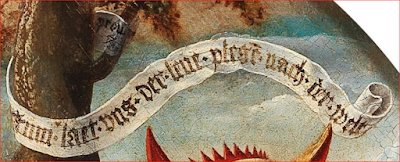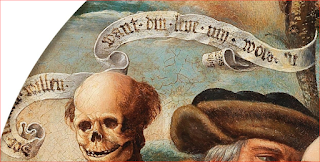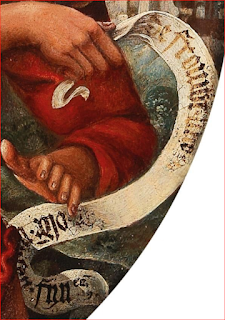The work was sold in April of this year at Abalartes, in Spain, for 5,000 Euro (which was very cheap), so this would be a very handsome profit in a few months time. I can't remember seeing that auction at that time, too bad.
UPDATE: a contact told me that it was sold for 30,000 Euro, 5,000 Euro was the estimate. Thanks!
Cranach the Elder, from the Museum of Catalunya
The work is based (as is said in the auction catalogue) very closely on a prototype by Lucas Cranach, and can be found in many variations in the 16th century in Germany and the Netherlands. This one is special with the two additional figures, and quite well painted.I doubt however that it is Netherlandish (or, as Abalartes said, Flemish), as the texts are in German (or just perhaps in some Limburgish, which is the language from the border region between Germany and the Netherlands around Maastricht and Maaseik).
The first text reads, as far as I can tell:
"Prou"? (top of the tree, no idea of meaning)
"...tum laet ons der leve plege nach der welt"
which means something (perhaps) like "let us care for the life after this world"
"Das(?) (?) Sotthen"
"Want din leve um wolde(?)"
And a text folded below, which is something like "Bisto? Suas" but is really undecipherable. I am not certain of "Sotthen", but it certainly looks similar and would be right in the context (as it means "Fools")
The very end, written smaller, seems to be "Sapi" and beneath it "32", so this may, just perhaps, be some signature and date? This is very tentative though.
The fourth and final text is "De frouwe ? ... wolde ? sijn", meaning "The woman wants to be ?" The question marks reads like "Dijsen", which doesn't have any meaning as far as I know, so I am clearly misreading this.
This text is to me, as far as I can read it, more German than Dutch. While this of course may be a Flemish painting made for the German market, it seems more likely that it is originally German to start with, considering the Cranach origin.
In favour of a Netherlandish origin is this work by Quentin Massys, now in the National Gallery of Art in Washington, which shows a fool in a very similar costume to the one added here on the right. Whether one painting is here based on the other for this detail, or whether it was a costume in common use at the time, is not known to me.
Similar fools caps can be seen in other works of the same period, like this engraving by Goltzius (via the Rijksmuseum). I can find older examples, from ca. 1530 on, so this doesn't really help to date the painting.
The value may be a bit high for an anonymous painting, but Cranach sells well and this is a very good work after Cranach, with an interesting image and possibilities for further research; and while not fresh on the market, it will be new for most bidders probably.
UPDATE: sold for 68,275 Euro!












I discovered this painting in a house in North Wales in the mid-1970s. A major auction house in London said it was a 19th century copy of a Cranach. Shows how much they knew! I’ve often wondered what happened to it.
ReplyDelete